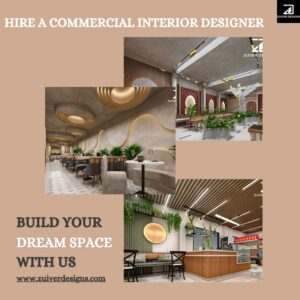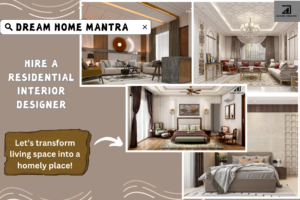As businesses continue to adapt to new work environments, commercial design trends for 2025 are being driven by technological advancements, sustainability, and employee well-being. The future of commercial spaces is all about flexibility, efficiency, and aesthetics that foster productivity and collaboration.
Whether you are planning a complete office revamp or looking to integrate new trends into your workspace, these five emerging trends will shape the commercial design landscape in 2025.
1. Sustainable and Eco-Friendly Designs
Sustainability is the top commercial design trend for 2025; with companies focusing on eco-friendly materials and energy-efficient solutions. Green building projects and LEED (Leadership in Energy and Environmental Design) certifications are becoming a necessity for contemporary office spaces.
Key Elements
Recycled and Sustainable Materials: The incorporation of reclaimed wood, recycled metal, and biodegradable furniture is gaining traction in commercial designs.
Energy Efficiency: Smart lights, energy-saving HVAC systems, and solar panels will become a common practice.
Biophilic Design: Bringing nature indoors with the use of natural elements such as indoor plants, living walls, and water features will contribute to improved indoor air quality and employee health.
Carbon Footprint Reduction: Sourcing local products and using carbon-neutral construction processes will be at the forefront for companies.
Sustainable Office Supplies: Companies will make more use of sustainable office supplies like biodegradable pens, recycled paper, and reusable ink cartridges.
Sustainable design is not simply an environmental commitment—it also lures green customers and workers who care about corporate citizenship.
2. Flexible and Hybrid Workspaces
The hybrid work environment is not going away, shaping office design trends to include both in-office and remote workers. Companies are abandoning static cubicle-based environments for flexible, multi-use spaces that foster a variety of workstyles.
Key Elements
Modular Furniture: Desks, chairs, and partitions will be reconfigurable, thus offering the flexibility to be rearranged as needed.
Collaboration Zones: Specified breakout spaces will promote teamwork, brainstorming, and social interaction.
Quiet Work Spaces: Soundproof booths and quiet pods will provide the staff with the space to enable focused, distraction-free work.
Hot Desking: Flexible seating will take over from assigned desk space, making the most of available space.
Remote Work Environments: Offices will be optimised with improved video conferencing systems and virtual working spaces to host hybrid teams.
A balanced office should be able to support all types of activities, ranging from collaboration to concentrated work, which makes flexible workplaces an essential 2025 trend.
3. Technology-Enabled Smart Offices
As technology rapidly advances, offices are becoming intelligent and interactive spaces. IoT integration and AI-enabled solutions will streamline workspaces and enhance employee experience.
Key Features
Smart Climate and Lighting Control: AI-based sensors will manage lighting and temperature based on occupation and preference.
Touchless: Touch-free entry systems, voice controls, and automatic sanitisation kiosks will provide convenience and hygiene.
AR/VR Collaboration Tools: Augmented and virtual reality will find applications in team meetings, design collaboration, and training programs.
Improved Cybersecurity: As remote work gains momentum, companies will spend on secure digital infrastructure and private cloud solutions.
AI-Powered Office Management: AI will be deployed for predictive maintenance, space management, and real-time analytics to create a more efficient work environment.
Technology-facilitated design not only maximises the efficiency of the workplace but also produces a hassle-free and future-proof office environment.
4. Wellness-Focused Office Spaces
Wellness of employees is taking center stage in commercial design. Offices are being created to accommodate physical and mental well-being, understanding that a healthy workforce equals a productive workforce.
Key Features
Ergonomic Seating: Adjustable standing desks, ergonomic seating, and anti-fatigue mats will alleviate strain and enhance posture.
Wellness Rooms: Quiet spaces, meditation rooms, and nap pods will offer areas for relaxation and mental restoration.
Natural Lighting: Utilising large windows and skylights to maximise daylight exposure will decrease eye strain and improve mood.
Active Workspaces: Adding treadmill desks, cycling stations, and in-office fitness spaces will promote movement during the workday.
Mental Health Support: Office areas will feature specific spaces for relaxation, therapy sessions, and stress-reducing activities.
By promoting a wellness-first mentality, companies can design an office space that improves productivity and job satisfaction.
5. Aesthetic and Experiential Design
The look of commercial buildings is no longer merely about aesthetics—it’s about designing an engaging and memorable experience. Businesses are creating offices that embody their brand while focusing on creativity and interaction.
Key Elements
Brand-Centric Design: Personalised wall graphics, business color palettes, and signature furniture elements will make workplaces more personalised.
Multi-Sensory Experiences: Scent marketing, acoustic design, and dynamic lighting will be employed to create certain emotions and boost the work environment.
Artistic Touches: Large-scale murals, digital art installations, and sculptures will bring character and creativity to commercial interiors.
Bold Color Palettes: Vibrant and mood-boosting colours will be incorporated into office designs to produce an energising environment.
Tailored Workspaces: Staff will be able to personalise their workspaces with digital desktop configurations and adjustable environmental settings.
A well-designed office isn’t merely a place to go to work—it’s an expression of company culture and values, enabling the best and brightest to attract and impress clients.
Wrap Up
Commercial design trends of 2025 place importance on sustainability, adaptability, technology, wellness, and experiential design. When companies embrace dynamic work, such trends will come together to make office space productive, interesting, and ready for the future. Whether it is renovating an office or developing a new commercial building, combining these trends into your project will make for an up-to-date, useful, and motivational place to work.
Furthermore, as commercial design progresses, companies should monitor upcoming developments like AI-powered space management, smart textiles, and even more immersive virtual workspaces. Keeping up with these trends will ensure that office space is not only productive but also dynamic and future-ready.





